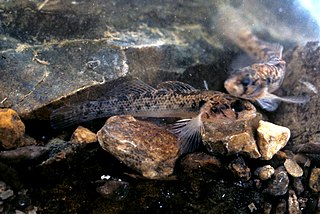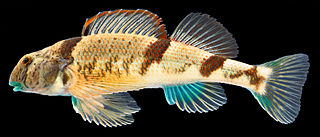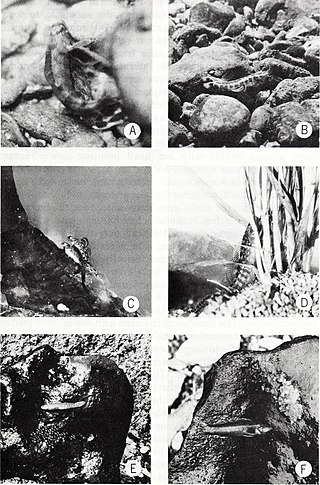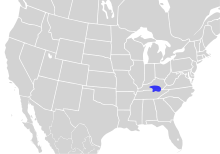The redband darter is a species of freshwater ray-finned fish, a darter from the subfamily Etheostomatinae, part of the family Percidae, which also contains the perches, ruffes and pikeperches. It is endemic to the state of Tennessee in the eastern United States.
The pinewoods darter is a species of freshwater ray-finned fish, a darter from the subfamily Etheostomatinae, part of the family Percidae, which also contains the perches, ruffes and pikeperches. It is endemic to the eastern United States where it is only known to occur in the Little Peedee River system in the Carolinas. It inhabits creeks, preferring gravel riffles and vegetated areas with strong currents. This species can reach a length of 7.6 centimetres (3.0 in) TL though most only reach about 5.2 centimetres (2.0 in).
The paleback darter is a species of freshwater ray-finned fish, a darter from the subfamily Etheostomatinae, part of the family Percidae, which also contains the perches, ruffes and pikeperches. It is endemic to Arkansas, United States. It is only known to occur in the Caddo River and in Hallmans Creek, a tributary of the Ouachita River. This species inhabits headwaters and creeks where it lives in rocky, shallow pools and also in springs with plentiful vegetation growth. This species can reach a length of 6 centimetres (2.4 in) TL though most only reach about 3.9 centimetres (1.5 in).

The striated darter is a species of freshwater ray-finned fish, a darter from the subfamily Etheostomatinae, part of the family Percidae, which also contains the perches, ruffes and pikeperches. It is endemic to the eastern United States. It occurs in the Duck River system in Tennessee. It inhabits rocky pools in creeks. This species can reach a length of 5.6 centimetres (2.2 in) TL though most only reach about 3.8 centimetres (1.5 in).

The blenny darter is a species of freshwater ray-finned fish, a darter from the subfamily Etheostomatinae, part of the family Percidae, which also contains the perches, ruffes and pikeperches. It is a poorly known species which occurs in Alabama and Tennessee where it inhabits swift riffles.

The teardrop darter is a species of freshwater ray-finned fish, a darter from the subfamily Etheostomatinae, part of the family Percidae, which also contains the perches, ruffes and pikeperches. It is endemic to the eastern United States. It is only found in Kentucky and Tennessee, where it occurs in the middle to upper reaches of the Green River drainage. It inhabits small rivers and creeks and rocky pools where it feeds on the larvae of blackflies and midges, immature stages of caddisflies and mayflies, and cladocerans and copepods. This species can reach a length of 6 cm (2.4 in), though most only reach about 4.2 cm (1.7 in). This species creates nests in which the females deposit their eggs and these are guarded by the male and have been found to contain between 40 and 80 eggs. The teardrop darter was first formally described by Robert A. Kuehne and James W. Small Jr. in 1971 with the type locality given as Brush Creek, a tributary of the Green River, 2.7 miles north of Liberty, Casey County, Kentucky. The specific name honours Professor Roger W. Barbour (1919-1993) in recognition of his contribution to the knowledge of Kentucky's vertebrate fauna.
The cherry darter is a species of freshwater ray-finned fish, a darter from the subfamily Etheostomatinae, part of the family Percidae, which also contains the perches, ruffes and pikeperches. It is endemic to the upper Caney Fork system of the Cumberland River drainage in the U.S. state of Tennessee.
The saffron darter is a species of freshwater ray-finned fish, a darter from the subfamily Etheostomatinae, part of the family Percidae, which also contains the perches, ruffes and pikeperches. It is endemic to the eastern United States, where it is found in streams and creeks in Kentucky and Tennessee.

The Highland Rim darter is a species of freshwater ray-finned fish, a darter from the subfamily Etheostomatinae, part of the family Percidae, which also contains the perches, ruffes and pikeperches. It is endemic to the eastern United States, where it is only known to occur in Tennessee and Kentucky in the Barren River system. This species can reach a length of 5.6 centimetres (2.2 in) SL.
The barcheek darter is a species of freshwater ray-finned fish, a darter from the subfamily Etheostomatinae, part of the family Percidae, which also contains the perches, ruffes and pikeperches. It is endemic to the eastern United States where it is only known to occur in the states of Kentucky and Tennessee in the Cumberland River drainage from the Big South Fork down to the Obey River. It is an inhabitant of smaller rivers, streams and creeks where it lives in small, rocky pools. This species can reach a length of 8.4 centimetres (3.3 in) TL though most only reach a length of 5 centimetres (2.0 in).
The guardian darter is a species of freshwater ray-finned fish, a darter from the subfamily Etheostomatinae, part of the family Percidae, which also contains the perches, ruffes and pikeperches. It is endemic to the eastern United States. This species inhabits creeks and headwaters, living in pools with gentle currents and adjacent riffles. This species can reach a length of 7.4 centimetres (2.9 in) SL.
The firebelly darter is a species of freshwater ray-finned fish, a darter from the subfamily Etheostomatinae, part of the family Percidae, which also contains the perches, ruffes and pikeperches. It is endemic to the eastern United States, where it is only known to occur in the drainage systems of the Obion and Forked Deer rivers of Kentucky and Tennessee. It inhabits gravel or sand-bottomed pools in creeks up to small rivers. This species can reach a length of 7 centimetres (2.8 in) TL.

The orangethroat darter is a species of freshwater ray-finned fish, a darter from the subfamily Etheostomatinae, part of the family Percidae, which also contains the perches, ruffes and pikeperches. It is endemic to the central and eastern United States where it is native to parts of the Mississippi River Basin and Lake Erie Basin. Its typical habitat includes shallow gravel riffles in cooler streams and rocky runs and pools in headwaters, creeks, and small rivers, with sand, gravel, rubble, or rock substrates. It forages on the bottom for the aquatic larvae of midges, blackfly, mayfly and caddisfly, as well as isopods and amphipods. Spawning takes place in spring, the selected sites often being the upper stretches of riffles with sandy and gravelly bottoms interspersed with larger cobble. Reproductive success is high in this species. No particular threats have been identified, and the International Union for Conservation of Nature has assessed its conservation status as being of "least concern".
The spottail darter is a species of freshwater ray-finned fish, a darter from the subfamily Etheostomatinae, part of the family Percidae, which also contains the perches, ruffes and pikeperches. It is endemic to the eastern United States. It is found in the Ohio River basin and in the Red River system of the Cumberland River drainage. It inhabits rocky pools and nearby riffles of flowing waters up to the size of small rivers.

The Swannanoa darter is a species of freshwater ray-finned fish, a darter from the subfamily Etheostomatinae, part of the family Percidae, which also contains the perches, ruffes and pikeperches. It is endemic to the eastern United States where it occurs in the drainage of the Tennessee River. It prefers flowing water in riffles in cool, clear mountain streams, with boulder substrates. The diet and natural history of this species have been little studied but are probably similar to those of its close relative, the greenside darter. The population trend of this fish seems to be stable and it is a common species with numerous sub-populations over its limited range, and the International Union for Conservation of Nature has assessed its conservation status as being of "least concern".
The striped darter is a species of freshwater ray-finned fish, a darter from the subfamily Etheostomatinae, part of the family Percidae, which also contains the perches, ruffes and pikeperches. It is found in the lower Cumberland River drainage in Kentucky and Tennessee, in the upper Caney Fork system in central Tennessee; and in Rockcastle River and nearby streams in eastern Kentucky. It inhabits rocky pools of headwaters, creeks and small to medium river. This species can reach a length of 7.8 cm (3.1 in), though most only reach about 4.8 cm (1.9 in).

The Kentucky arrow darter, sometimes known as the Cumberland Plateau darter, is a species of freshwater ray-finned fish, a darter from the subfamily Etheostomatinae, part of the family Percidae, which also contains the perches, ruffes and pikeperches. It is endemic to the eastern United States, where it is found only in the upper Kentucky River drainage in Kentucky. It inhabits rocky riffles and pools of headwaters, creeks and small rivers. This species can reach a length of 12 cm (4.7 in).
The Kentucky darter is a species of freshwater ray-finned fish, a darter from the subfamily Etheostomatinae, part of the family Percidae, which also contains the perches, ruffes and pikeperches. It is endemic to the eastern United States, where it occurs in the upper Green and Gasper River systems in Kentucky. It inhabits rocky pools and adjacent riffles of creeks and small rivers. It has a diet that mainly consists of mayflies, larval blackflies, midges and occasionally various insect larvae. This species can reach a length of 6.5 cm (2.6 in).
The Shawnee darter is a species of freshwater ray-finned fish, a darter from the subfamily Etheostomatinae, part of the family Percidae, which also contains the perches, ruffes and pikeperches. It is endemic to the eastern United States, where it occurs in the upper Pond River in Kentucky. It inhabits shallow gravel riffles and rocky runs and pools of headwaters, creeks, and small rivers. This species can reach a length of 5.4 cm (2.1 in).
The brook darter is a small species of freshwater ray-finned fish, a darter from the subfamily Etheostomatinae, part of the family Percidae, which also contains the perches, ruffes and pikeperches. It is endemic to the eastern United States, where it occurs in the upper Black River system in Missouri, from headwaters to where the River flows into the Mississippi River alluvial plain. It inhabits shallow gravel riffles, sometimes rocky runs and pools, of headwaters, creeks, and small rivers. The brook darter was first formally described in 1997 by Patrick A. Ceas and Lawrence M. Page with the type locality given as the Black River on the northeastern outskirts of Mill Spring, Missouri. The specific name honours Brooks M. Burr, Emeritus Professor and Curator of Fishes of Southern Illinois University who first brought the fish to the attention of the authors.








